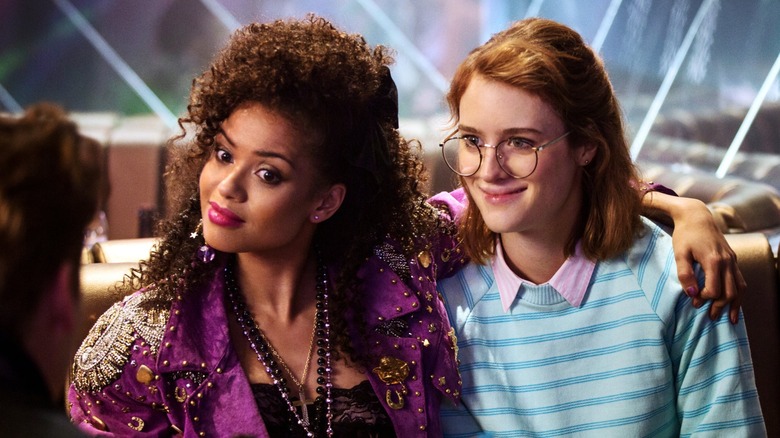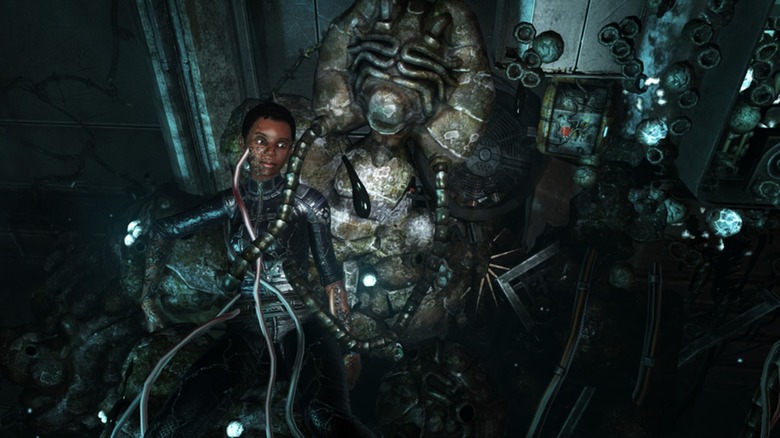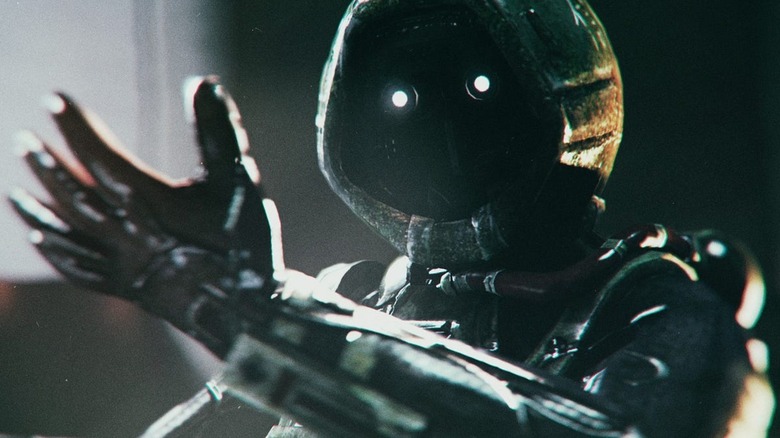Black Mirror's Happiest Episode Is A Reimagining Of This Sci-Fi Horror Story
This post contains spoilers for "San Junipero" and "Soma."
"Black Mirror" rarely lingers on hope or the beauty of a loving relationship. This is part of the reason why Season 3's "San Junipero" is so impactful, where the prospect of queer love transcending the show's usual thematic impulses evokes a sweet, endearing feeling. In this episode, technology isn't an obstacle to human sentiment — on the contrary, it is a conduit for eternal love between two women who couldn't be with one another in the real world. There's plenty of pathos in the story, mainly in the form of ingrained homophobia in society and its horrid consequences, along with the tragedy of a life that unexpectedly takes a turn for the worse. However, the fact that Kelly (Gugu Mbatha-Raw) and Yorkie (Mackenzie Davis) choose to be together in a virtual afterlife is what matters in the end, establishing a reality where their love will endure forever.
"Black Mirror" creator Charlie Brooker had initially envisioned an unhappy ending for Kelly and Yorkie, but changed it after realizing that a reunion was more emotionally fulfilling than an ache-filled separation. This realization led him to work out Yorkie's eventual euthanasia (that would facilitate the existence of her consciousness within the simulation) and expand on some emotional aspects of the central relationship. This decision worked in favor of the episode, as viewers conditioned to nurture cynicism or expect bleakness from "Black Mirror" were pleasantly disarmed by the tender sincerity of the ending. Given how fleshed out the Kelly/Yorkie dynamic is, there's little time (or need) to inspect the downsides of the technology that makes their reunion possible. Perhaps, in this iteration of the story, there are no unhappy accidents, no terrifying consequences.
The same cannot be said about "Soma," Frictional Games' chillingly profound psychological horror game that presents the concept of virtual afterlife as pure nightmare fuel. No, it is actually way worse than that, as "Soma" is the kind of game that dives right into the turgid waters of existential horror and ensures that you remain drowned. The video game was released a year before the "Black Mirror" episode, making "San Junipero" an optimistic reimagining of a story that highlights the nastiest aspects of human identity. Let's explore the hopelessly bleak landscape of "Soma," where every choice you make is a moral one.
In Soma, the rebirth of consciousness changes what it means to be human
"San Junipero" presents the rebirth of consciousness as a painless process, mostly removed from ethical dilemmas (save for the act of euthanasia, which boils down to personal choice and autonomy). The consciousness of every person in San Junipero remains intact, as the simulation doesn't change or tarnish their core selves in any way, but only provides an eternal sanctuary for them to live on.
"Soma" begins with a similar promise, where a young Simon Jarrett is offered an experimental treatment after he survives a near-fatal car accident that causes a terrible brain injury. The idea is to simply undergo an unconventional brain scan in the year 2015 (which doesn't immediately raise any red flags), leading Simon to agree. After he unexpectedly blacks out, Simon wakes up in an abandoned underwater research facility, having no idea where he is or how he got here. Simon's visceral fear of the unknown overlaps with the player's, and the two must work together to get to the bottom of a hellish existential mystery.
On paper, "Soma" might seem like a standard survival horror of the "Dead Space" variety, but it uses genre tropes to probe deeper into the politics of human identity and whether it can persist when completely severed from the core self. As Simon roams through the geothermal power center of PATHOS-II, he learns that the current year is 2104 (!), and that the Earth has ceased to exist after a comet collision. PATHOS-II is apparently humanity's final outpost, but these massive revelations pale in comparison to Simon's disorienting journey, where he encounters crushed, mutilated robots who desperately believe (and sound like) they're human. At one point, a human plugged to a machine screams in agony and weeps in confusion, and Simon has no choice but to unplug her to progress further.
Even when non-humanoid robots need to be unplugged, they cry out in pain and beg Simon not to kill them. Is this pain "real?" And even if it isn't, is it any easier to pull the plug and pretend like a consciousness wasn't snuffed out? "Soma" constantly asks these uncomfortable questions, proving that the concept of what is considered human is more complicated than it seems. When Simon is forced to make clones of himself to solve puzzles and kill them right after, the line between "core self" and "copy" begins to blur, until it vanishes altogether.
Soma asks whether humanity can be saved when sentient beings are no longer human
After Simon meets Catherine, a PATHOS-II employee, we learn that humanity's final hope is a simulated universe named ARK, which will house the uploaded consciousness of everyone (who are no longer alive) in simulated bodies. This sounds rather hopeful (just like the simulated town of San Junipero, but on a grander scale), but none of the actual, living employees had factored in the horror of various copies of the same consciousness existing at once, where every copy believes itself to be a direct continuation of the core self. Every copy, or copy of a copy, has its own inclinations and sense of self, each one of them human while being no longer human, forever at the risk of being deleted by another digital consciousness with the power to do so.
Simon has done the same himself, after all. What happens when the Simon who woke up on PATHOS-II realizes that he is a twice-removed copy of the "real" Simon? We gradually learn that the Simon from 2015 has been dead for decades, the only proof of his existence being the experimental brain scan, which has stored his consciousness and passed it on to various human bodies. Moreover, the version of Simon that presses the launch button for the ARK soon realizes that he will be left behind, as his job was to ensure humanity's survival at the cost of his own. In the end, Simon is left alone in the literal dark, utterly helpless in a power facility that no longer houses any sentient beings, except for the ones who were previously left to their own devices.
To twist the knife further, Simon had previously proclaimed, "They're not us!" when referring to the copies that survive on the ARK, creating a distinction between himself/Catherine and the digital uploads chosen for survival. If both versions are equally human, then why does one's existence hold more weight than the other's?
"Soma" reminds us that the concept of eternal consciousness is less like a file transfer, but more like undergoing a scan inside an Xerox machine and being faced with various versions of oneself. The ones freshly created are also you, carrying the same conviction to persist/survive, to emerge as the only one worthy of being called human. The message is clear: humans consciously hurt other sentient beings for self-preservation, no matter what kind of existence that might prove to be. To drive this home, the game repeatedly gives you the option to either euthanize a self-copy or spare them long enough to push them toward existential psychosis. There's no comfort in either choice.


